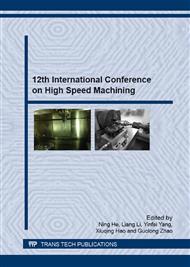p.3
p.13
p.20
p.29
p.36
p.43
p.48
p.56
Experimental Investigation of Mechanical-Thermal Characteristics in High Efficiency Turning Titanium Alloy Ti6Al4V
Abstract:
Titanium alloy Ti6Al4V has poor machinability, which leads to high unit cutting force and cutting temperature, rapid tool failure. In this study, the effect of the cutting speed, feed rate and cooling condition on cutting force and cutting temperature is critically analysed by turning experiment. At the same time, the relationship is established among tool wear, cutting force and cutting temperature. This investigation has shown that cutting speed is the decisive factor which increasing cutting force and cutting temperature. In the process of turning, tool wear results in high amounts of heat and mechanical stress, which leads to serious tool wear. The Minimal Quantity Lubrication reduces the frictional condition at the chip-tool, decreases cutting force and cutting temperature, and delays the tool failure.
Info:
Periodical:
Pages:
20-28
Citation:
Online since:
January 2016
Authors:
Keywords:
Price:
Сopyright:
© 2016 Trans Tech Publications Ltd. All Rights Reserved
Share:
Citation:


